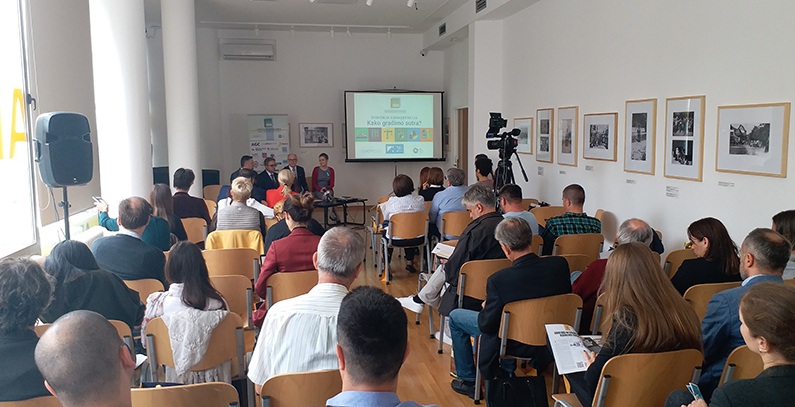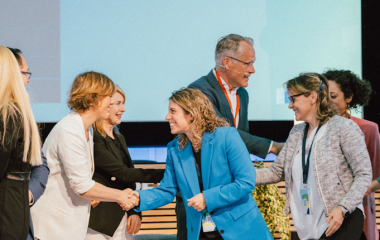
Photo: SrbGBC organized a conference in Belgrade titled "How do we build tomorrow?"
A green building will not pollute the environment during construction or use. This will benefit the residents as they will have better working and living conditions, but also their neighbors, because the building will produce, for example, less noise. Reduced CO2 emissions are also one of the benefits of the green building concept – buildings consume energy, but if they are properly designed, consumption will be lower, Martin Elezović, a member of the board of directors of the Serbia Green Building Council (SrbGBC), has told Balkan Green Energy News.
Green building, however, does not refer to energy and pollution only, but it also entails compliance with professional standards, from planning to design, construction, maintenance, and operation, with the aim of improving the quality of peoples’ lives and reducing the environmental impact. This concept is particularly important in the context of climate change since buildings and the construction industry are responsible for 39% of CO2 emissions.
Edin Dalifi, XELLA Srbija: In our production we use 75% of our waste
Our mission is sustainable production and construction. We have implemented a string of measures in order to make our production in Vreoci, Serbia sustainable, and one of these measures is the use of steam from the facility that supplies heat for Lazarevac. All our raw materials are sourced locally, close to our production site. Our YTONG building blocks have outstanding thermal properties, non-flammability and eco-friendly composition. Also, in our production we use 75% of our waste, which additionally reduces CO2 emissions.
“One of the recent trends is Life-cycle Assessment (LCA) which analyses a building’s impact on the environment, from receiving aggregate and producing cement to construction and operation, to demolition and recycling,” according to Elezović, who is a licensed energy efficiency engineer, BREEAM International Assessor, In-Use Assessor and Accredited Professional, as well as a DGNB Consultant.
Determining whether a building is green or not involves the application of certification systems such as BREEAM, LEED, and DGNB, which are based on 50 to 150 criteria.
 Ivana Petronijević, ALUMIL YU Industry: Solar energy for lighting
Ivana Petronijević, ALUMIL YU Industry: Solar energy for lighting
Our company contributes to green building through raw materials we use for aluminum profiles and through the very production process, in which, for example, we use solar energy to activate outdoor lighting, while at the same time we pay particular attention to energy and wastewater management. We use recycled raw materials for our products, and each customer can get information on how much such materials was used in a product. On top of that, we provide constant education for our employees, but also our partners.
“In this way, the building’s owner receives an independent confirmation that he took care of some things that others did not. Tenants, as well, increasingly pay attention to this, which speaks of a raised awareness of the importance of the sustainability of buildings, and this trend will continue,” according to Elezović.
The criteria include energy consumption and management, water consumption and management, pollution (noise, wastewater, lights), and the quality of materials (whether they are sustainable or not), management during design, and management during works.

One of the most important standards, or certificates, for materials is EPD, which covers the entire lifecycle of a product and, based on that, shows its environmental impact. EPD is not mandatory in Serbia, and the situation is similar in some European countries, but this will change over time, according to him.
As part of World Green Building Week, taking place from September 23 to 29, SrbGBC organized a conference in Belgrade today titled “How do we build tomorrow?” The theme of the conference is the World Green Building Council’s (WorldGBC) campaign #BuildingLife, whose aim is to raise awareness of CO2 emissions in all stages of a building’s lifecycle.
Srđan Stojakov, SIKA Srbija: Some of our products cut energy consumption by up to 30%
The green building concept implies reducing the consumption of energy and water, waste, as well as CO2 emissions. Our company prepares numerous reports which help us introduce new measures. One of such measures is the opening of small-scale production facilities, such as the one in Šimanovci, Serbia, which shortens the path from raw material to production and the construction site, reducing CO2 emissions, while some of our products can cut energy consumption by up to 30%.
Participants in the conference included Goran Trivan, the Minister for Environmental Protection, and Stevica Deđanski, a state secretary at the Ministry of Mining and Energy, as well as experts and representatives of companies from sectors that form part of a building’s lifecycle – manufacture and construction, design and use, as well as demolition and recycling.


















Be the first one to comment on this article.